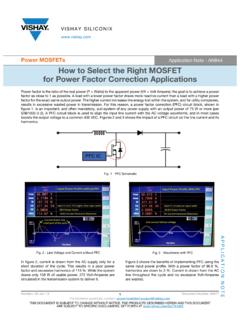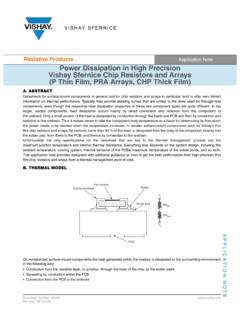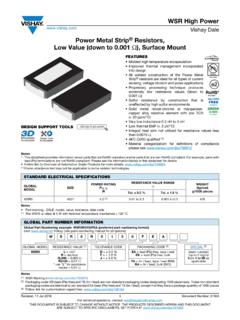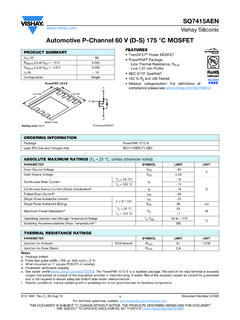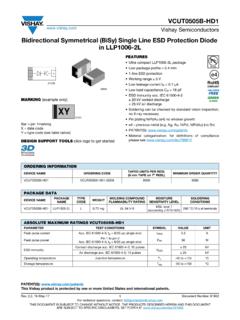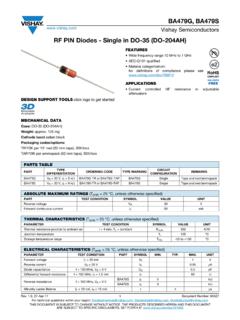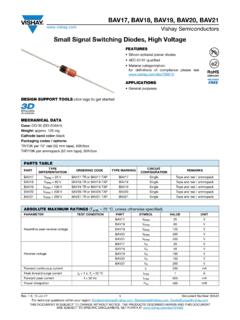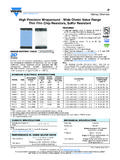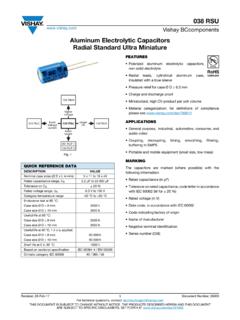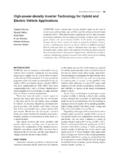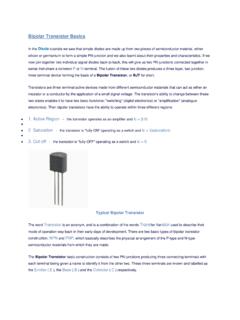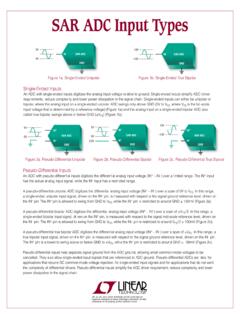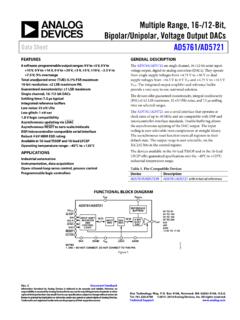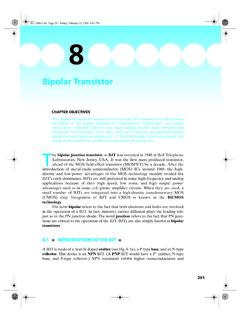Transcription of Measuring Power MOSFET Characteristics
1 Document Number: : 18-Nov-101 This document is subject to change without notice. THE PRODUCTS DESCRIBED HEREIN AND THIS DOCUMENT ARE SUBJECT TO SPECIFIC DISCLAIMERS, SET FORTH AT SILICONIXP ower MOSFETsApplication Note AN-957 Measuring Power MOSFET CharacteristicsAPPLICATION NOTETABLE OF CONTENTSPage1. General Information .. 22. BVDSS .. 33. IDSS .. 34. VGS(th) .. 35. 46. 47. RDS(on) .. 58. 59. Composite Characteristics .. 610. Transfer Characteristics .. 611. Measurement of Power MOSFET Characteristics without a Curve Tracer .. 612. A Fixture to Speed-up Testing Time .. 9 This application note describes methods for Measuring Power MOSFET Characteristics , both with a curve tracer and withspecial-purpose test circuits.
2 Measuring Power MOSFET Characteristics Number: 907152 Revision: 18-Nov-10 This document is subject to change without notice. THE PRODUCTS DESCRIBED HEREIN AND THIS DOCUMENT ARE SUBJECT TO SPECIFIC DISCLAIMERS, SET FORTH AT Note AN-957 Vishay SiliconixAPPLICATION NOTETOPICS COVERED: Converting the nomenclature from bipolars to MOSFETs P-channel Power MOSFETs Initial settings Breakdown Drain leakage Gate threshold Gate leakage Transconductance On-resistance Diode drop Characteristics in synchronous rectification Transfer Characteristics Measurements without a curve tracer Device capacitances Switching times Gate charge Reverse recovery A fixture to speed-up testing time Related topics1.
3 GENERALC urve tracers have generally been designed for makingmeasurements on bipolar transistors. While PowerMOSFETs can betested satisfactorily on most curve tracers,the controls of these instruments are generally labeled withreference to bipolar transistors, and the procedure to followin the case of MOSFETs is not immediately obvious. Thisapplication note describes methods for Measuring PowerMOSFET Characteristics , both with a curve tracer and withspecial-purpose test circuits. Testing Power MOSFETs on acurve tracer is a simple matter, provided the broadcorrespondence between bipolar transistor and PowerMOSFET features are borne in mind.
4 Table 1 matches somefeatures of Power MOSFETs with their bipolar Power MOSFET used in all the examples is the controlsettings given in the examples are those suitablefor the IRF630. The user must modify these valuesappropriately when testing adifferent device. The IRF630was selected since it is a typical mid-range device with avoltage rating of 200 V and acontinuous current rating of 9 A(with TC = 25 C). For measurements with currents above20 A, or for pulsed tests notcontrolled by the gate, theTektronix 176 Pulsed High Current Fixture must be usedinstead of the standard test IRF630 is an n-channel device. For a p-channel device,all the test procedures are the same except that the positionof the Polarity Selector Switch must be reversed - that is, forp-channel devices, it must be in the PNP curve tracer used as an example in this application noteis a Tektronix 576, since this instrument is in widespreaduse.
5 However, the principles involved apply equally well toother makes and models. Figure 1 shows the layout of thecontrols of the Tektronix 576 curve tracer, with majorcontrols identified by the names used in this applicationnote. Throughout this applicationnote, when controls arereferred to, the name of the control is printed in capitals. Forall tests, when the Power is on, the initialstate of the curvetracer is assumed to be as follows: Left/right switch in off position Variable collector supply at zero Display not inverted Display offset set at zero Step/offset polarity button out (not inverted) display magnifier set at norm (off) The rep button of the step family selector should be in The aid button of the offset selector should be in The norm button of the rate selector should be in Fig.
6 1 - Location of controls in a 576 curve tracerThe accuracy of all tests is predicated on the correct use ofthe Kelvin connections, as indicated in the instructions forthe curve tracer. This is particularly important for powersemiconductors, as inductive and resistive drops acrosssockets and wiring are significant. Some tests require the use of high voltages. After the deviceis mounted in the test fixture as described for each test, thetest fixture safety cover should be closed and the curveMeasuring Power MOSFET CharacteristicsApplication Note AN-957 Vishay SiliconixAPPLICATION NOTE Document Number: : 18-Nov-103 This document is subject to change without notice. THE PRODUCTS DESCRIBED HEREIN AND THIS DOCUMENT ARE SUBJECT TO SPECIFIC DISCLAIMERS, SET FORTH AT manufacturer s safety warnings heeded.
7 The exposedmetal parts of many Power MOSFETs (for example, the tabof TO-220 devices) are connected to the drain and aretherefore at the potential of the collector with any semiconductor device, some of thecharacteristics of Power MOSFETs are temperaturedependent. For tests in which there is significant heating ofthe Power MOSFET , a low repetition rate should be tests involving a slow transition through the linearregion, a damping resistor of at least 10 should beconnected in series with the gate, close to the gate lead toprevent oscillations. If frequent testing of MOS-gateddevices is expected, the use of a test fixture that plugsdirectly into the curve tracer would save a significantamount time.
8 Such a fixture is descibed in Section transistors are static sensitive. Wrist straps,grounding mats and other ESD precautions must befollowed, as indicated in BVDSSThis is the drain-source breakdown voltage (with VGS = 0).BVDSS should be greater than or equal to the rated voltageof the device, at the specified leakage Connect the device as follows: drain to C , gate to B ,source to E .2. Set the max. peak V to 350 Set the series resistor to limit the avalanche current to asafe value ( , tens of mA). A suitable value in this casewould be 14 k .4. Set the polarity switch to The mode control should be set to V/div. should be set at 50 V/div. on the collector current/div.
9 Should be set at 50 On the plug-in fixture, the connection selector should beset to short in the emitter grounded sector. Thisaction grounds the gate and disables the step Connect the device using the left/right switch. Increasethe collector supply voltage using the variable collectorsupply control until the current (as indicated by the traceon the screen) reaches 250 A. (see figure 2.) ReadBVDSS from the screen. Fig. 2 - Drain-source breakdown voltage3. IDSSThis is the drain current for a drain-source voltage of 100 %of rated voltage, with VGS = 0. This measurement is made inthe same manner as BVDSS, except that:1. The mode switch is set to leakage .2. Connect the device using the left/right switch and adjustthe collector supply voltage to the rated voltage of thePower MOSFET (200 V for the IRF630).
10 Read the valueof IDSS from the display (see figure 3). The verticalsensitivity may need altering to obtain an appropriatelysized display. Often IDSS will be in the nA range and thecurrent observed will be capacitor currents due to minutevariations in collector supply voltage. Fig. 3 - Drain-source breakdown voltage4. VGS(th)This is the gate-source voltage which produces 250 A ofdrain current (VDS = VGS). At this gate-source voltage thedevice enters the active region. In circuits where devices areconnected in parallel, switching losses can be minimized byusing device swith closely matched threshold voltages. Thistest requires the gate to be connected to the drain andconducted as follows:1.
